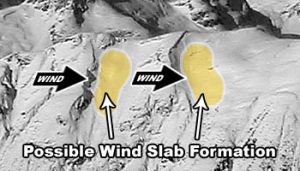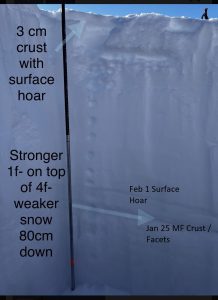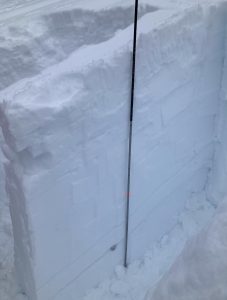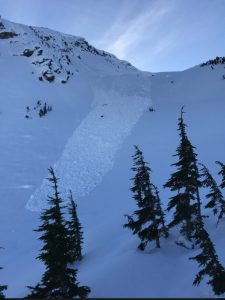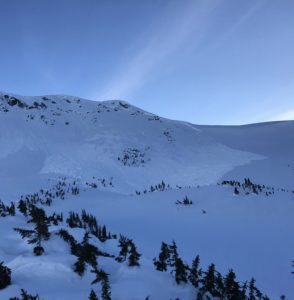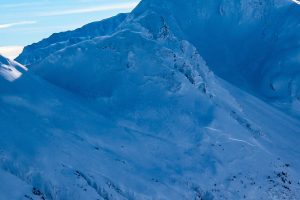Haines Avalanche Center
Above 2,500ftConsiderable
1,500 to 2,500ftConsiderable
Below 1,500ftModerate
Degrees of Avalanche Danger
Avalanche Problems
Problem 1
The Bottom Line: A new NW wind event is ongoing, and with plenty of snow available for transport, we are seeing active wind loading from treeline and up. These fresh wind slabs will be reactive to human weight, and anywhere from 1-3ft thick in wind loaded areas. They are being held up by weak storm snow and facets. Human triggering is likely on slopes steeper than 30 degrees. Be especially careful to avoid steep, wind loaded, sunny aspects.
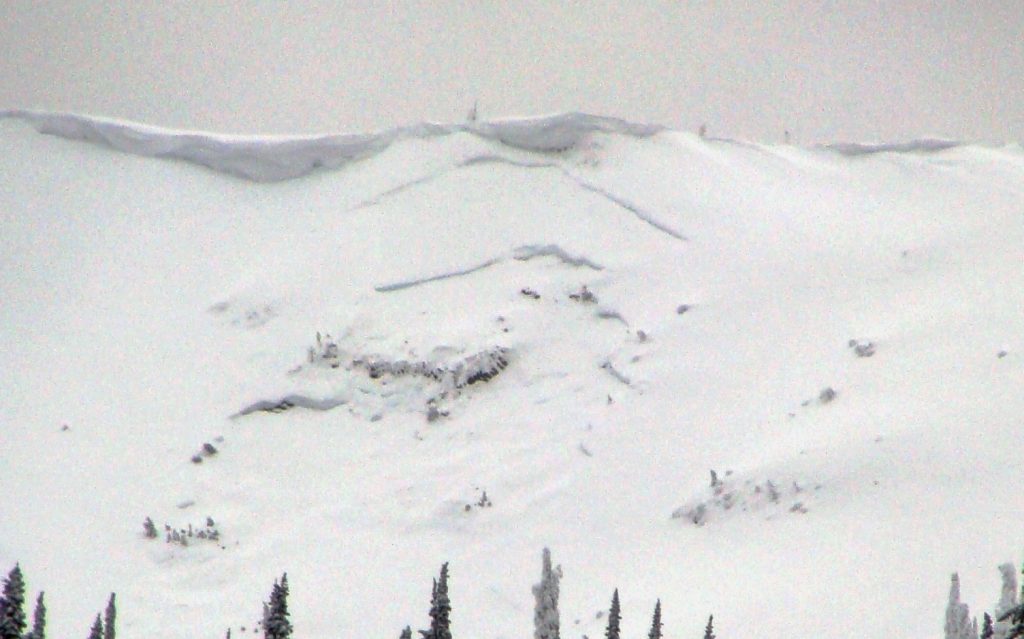
Photo: Example of a wind loaded slope with a wind slab avalanche that stepped down to deeper persistent layers below. This one was probably triggered by cornice fall. Photo from Flathead Avalanche Center.
Wind slabs can be avoided by sticking to sheltered or wind-scoured areas. Also from the wind, cornices might be unsupported, scoured, and weak. Tread carefully around them and limit your exposure to slopes below them. A cornice drop could cause a slide, with potential for a step down.
The severe consequences of our avalanche problems remain, due to deep persistent layers. Be hypersensitive of terrain- it is an active way to manage our exposure to the risk of an unlikely but high-consequence deep slab avalanche.
When on or near avalanche terrain, be diligent on terrain selection, group management, and human factor. Travel one at a time or with enough spacing so that only one person is exposed to an avalanche path at any one time. Be prepared for an avalanche that could step down to deeper instabilities, creating a slide that could break very wide, and take out all the “safe” zones on a slope. Be extra careful not to group up in places that an avalanche can reach.
Likelihood:
- Almost Certain
- Very Likely
- Likely
- Possible
- Unlikely
Size:
- Historic
- Very Large
- Large
- Small
Trend
- Increasing
- Steady
- Decreasing
Problem 2
When seeking out wind protected zones, remember that wind-protected pockets may be harboring weak, buried surface hoar layers. Protected means preserved.
Jan 25th melt freeze crust is ~4-5′ deep sitting on top of it are near surface facets, and buried surface hoar from Feb 1-4.
Snow pit from Feb 22 in Lutak (NE aspect 1800ft) showing persistent weak layers below the snowfall from Feb 10-15.
Likelihood:
- Almost Certain
- Very Likely
- Likely
- Possible
- Unlikely
Size:
- Historic
- Very Large
- Large
- Small
Trend
- Increasing
- Steady
- Decreasing
Problem 3
Cornices have become very large and weak. They are undercut, overhanging, and slowly sagging as they grow. Strong sunshine and increasing winds will put a lot of stress on these dangerous beasts. Stay way back from any snow ledges or cornices on ridgelines or summits. Some may fall naturally, so do not travel below them. More likely will be human triggering of cornices from above. When a cornice fails, it will break way further back on the ridge than expected and take most of the flat terrain out with it. Any cornice falls are likely to trigger very large and deadly deep-slab avalanches. Consequences are very high right now!
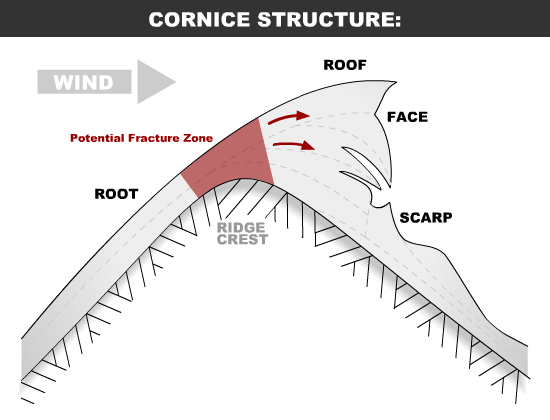
Likelihood:
- Almost Certain
- Very Likely
- Likely
- Possible
- Unlikely
Size:
- Historic
- Very Large
- Large
- Small
Trend
- Increasing
- Steady
- Decreasing
Problem 4
An unlikely to trigger, but high consequence deep slab layer remains. The “Big Warm-Up layer” from Nov 17th is not to be forgotten about. Although currently dormant, a smaller slide triggered on the upper snowpack could step down and trigger this deadly beast.
Lutak, Feb 4 PST 70/130 End down 130 rounding faceted polycrystals.
Likelihood:
- Almost Certain
- Very Likely
- Likely
- Possible
- Unlikely
Size:
- Historic
- Very Large
- Large
- Small
Trend
- Increasing
- Steady
- Decreasing
Avalanche Activity
March 2: Small natural soft slabs were observed in steep trees in the Lutak zone. This kind of small to large natural activity is likely widespread in the Lutak zone.
Feb 19-23: 6 different observations of natural avalanches in the transitional zone and in the Chilkat range. The natural D2 slides were on all aspects, a few on lower angle, all running on a mid-snow pack layer, and a majority with widespread propagation.
A larger, D3-R4 natural avalanche was observed near Four Winds on a S, SW aspect, down 60-120cm, it looked like a loose wet slide that maybe stepped down to a lower layer. Widespread propagation.
Feb 9: Glide cracks ~3000-3400′ in the transitional zone on N, NE aspects. Also notable was observation of reloading of bed surfaces on previous slides.
Jan 28: Lutak Zone
Glory Hole NW-aspect around 3,200′
Multiple wide propagating natural slides released during Jan 25-29th- a link to an archive of photos coming soon.
Weather
Forecast:
Expect mostly clear skies, solar radiation, and strong NW winds Saturday and Sunday, with temperatures dropping into the single digits. We will be under strong high pressure for several days with no storms in sight.
Recent Weather Summary:
- March 1st brought a strong and cold storm, with 10-15″ of new snow inland, and 30″+ in the Lutak zone.
- Late Feb 20-Feb 23 a cold high pressure system with moderate to strong N, NW winds
- Feb 19-Feb 20- warmer, solar effect on south aspects, valley fog on the 19th at ~1500-2000 ft.
- Feb 12 freezing levels 1250ft
- Incremental snow (more in Lutak zone) since Feb 5th, periods of moderate S/SE winds
- Feb 1-4 Near surface facets on top of crust from Jan 25 warm-up
- Jan 17-26 brought around 5″ of precip (3-5feet of new snow above 3000ft), strong SE winds, and a noticeable warmup
- Surface Hoar and Near Surface Facet growth Jan 8-10
- A strong front brought 24-30″ of snow above 2000ft on Jan 2nd.
- There was widespread Surface Hoar growth on Dec 31st.
- Complete Season Histories: Transitional Zone Lutak Zone
| Snow Depth | Last 24-hr Snow/SWE | Last 3-days Snow/SWE | Today’s Freezing Level | Today’s Winds | Next 24-hr Snow/SWE | |
| Mount Ripinsky @ 2,500′ | 152″ | 0″ / 0.00 | 34″ / 2.00 | 0′ | strong, NW | 0″ / 0.00″ |
| Flower Mountain @ 2,500′ | 69″ | 0″ / 0.00 | 15″ / 1.00 | 0′ | strong, NW | 0″ / 0.00″ |
| Chilkat Pass @ 3,100ft | 41″ | 0″ / 0.00 | 6″ / 0.30 | 0′ | strong, NW | 0″ / 0.00″ |
Additional Information
WEAR A HELMET! Be careful of rocks and hidden hazards. Be prepared for crevasses when on a glacier.
Are your riding companions trained and practiced in avalanche rescue? Everyone in your group needs to have a beacon, shovel, and probe, and know how to use them. Our mountains have very limited cell coverage, carry an emergency communication device and enough gear to spend the night.
Avalanche Canada’s Daily Process Flow – Utilize this every day you go out in the mountains.
Announcements
Click the +Full Forecast link below for each zone to read more. If you see any recent natural avalanche activity, or signs of instability please submit an observation.
